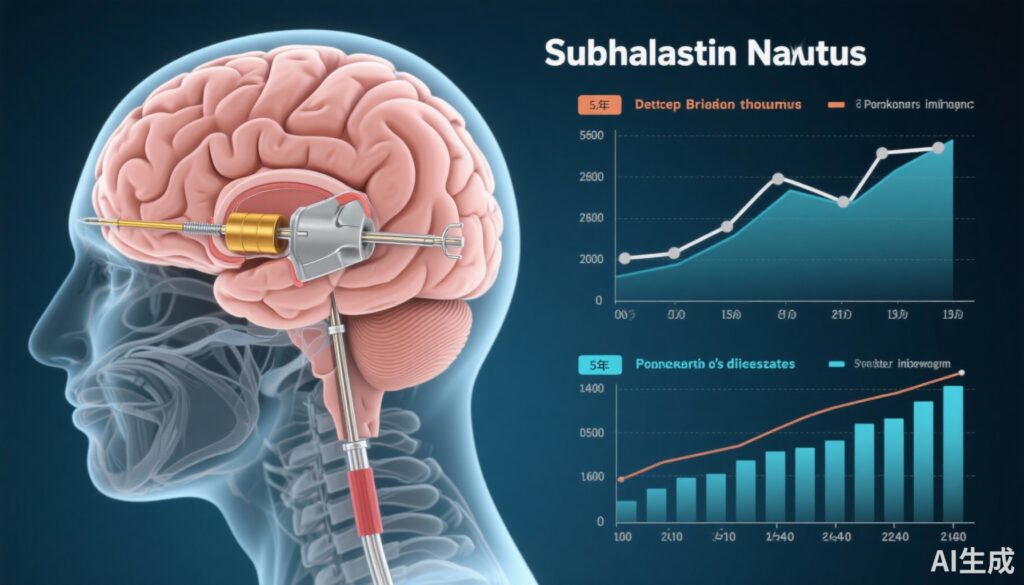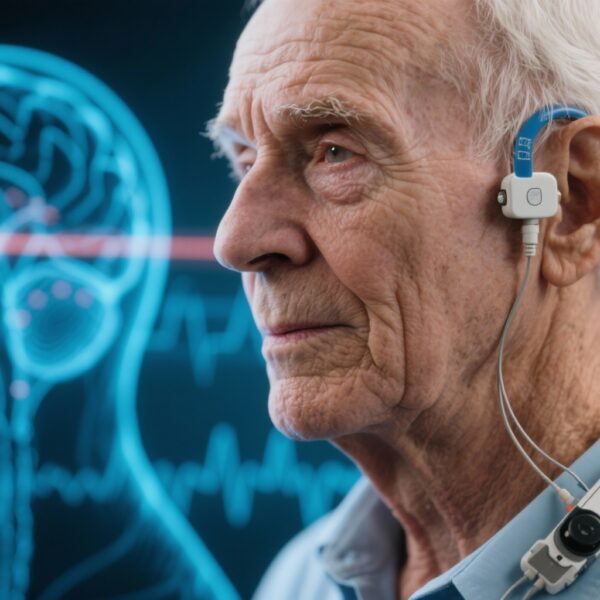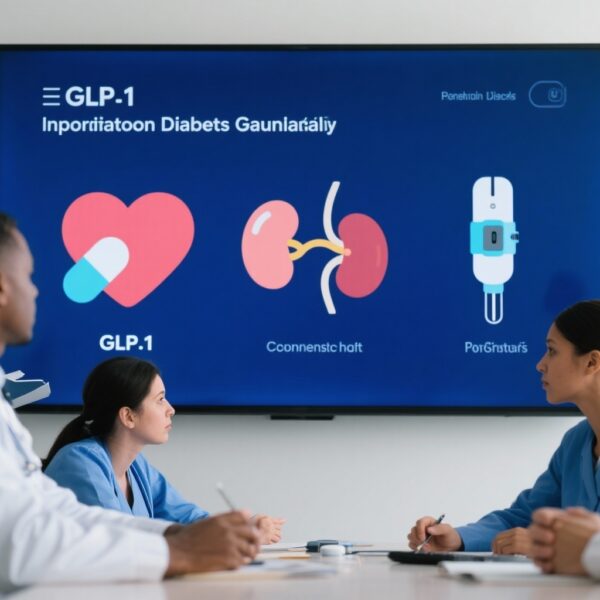Highlight
– Subthalamic nucleus deep brain stimulation (STN-DBS) produces durable motor improvement in Parkinson disease (PD) over five years.
– STN-DBS significantly suppresses dyskinesia and improves activities of daily living without medication.
– A stable 28% reduction in levodopa-equivalent dose is maintained throughout five years.
– Treatment shows a favorable safety profile, with infections as the most common serious adverse event.
Study Background and Disease Burden
Parkinson disease (PD) is a progressive neurodegenerative disorder affecting over 6 million people worldwide, characterized primarily by motor symptoms such as bradykinesia, rigidity, tremor, and postural instability. As the disease advances, motor fluctuations and dyskinesia induced by chronic levodopa therapy significantly impair quality of life and functional independence. Despite optimized pharmacotherapy, many patients experience suboptimal symptom control over time. Deep brain stimulation (DBS) targeting the subthalamic nucleus (STN) has emerged as an effective surgical adjunctive therapy providing motor symptom relief.
However, the long-term durability and safety profile of STN-DBS beyond two to three years remain incompletely characterized in large randomized controlled trials. The INTREPID trial was designed to address this gap by evaluating the five-year clinical outcomes and safety of STN-DBS using the Vercise DBS system in a rigorously controlled, prospective multicenter study. This is critical to guide clinical decisions on patient selection, counseling, and management strategies in moderate to advanced PD.
Study Design
INTREPID was a prospective, randomized (3:1 ratio), double-blind, sham-controlled phase conducted over 12 weeks, followed by an open-label extension up to five years across 23 US movement disorder centers. The study enrolled 313 patients with bilateral idiopathic PD of more than five years’ duration, characterized by significant motor disability (modified Hoehn and Yahr scale >2) and poor motor function exceeding six hours daily. Inclusion criteria mandated a Unified Parkinson’s Disease Rating Scale motor score (UPDRS-III, medication-off) of at least 30 points and a responsive improvement of 33% or greater with medication.
Subjects randomized to the active group received bilateral implantation of STN-DBS leads with the Vercise DBS system and stimulation initiated postoperatively. Control patients received sham stimulation to maintain blinding. Primary endpoints included changes in motor function (UPDRS-III), severity of dyskinesia, activities of daily living (UPDRS-II), and assessment of safety events.
Key Findings
Of 191 patients receiving DBS, 137 (72%) completed the five-year follow-up. The cohort had a mean age of 60 years and 73% were male.
- Motor Function Improvement: UPDRS-III scores off medication improved dramatically from a baseline mean of 42.8 to 21.1 at 1 year (51% improvement, 95% CI: 49%-53%, P < .001), slightly declining but persisting at 27.6 (36% improvement, 95% CI: 33%-38%, P < .001) by year 5.
- Activities of Daily Living: UPDRS-II scores off medication improved from 20.6 to 12.4 at year 1 (41% improvement, 95% CI: 38%-42%, P < .001) and were sustained at 16.4 (22% improvement, 95% CI: 18%-23%, P < .001) after five years.
- Dyskinesia Suppression: Dyskinesia scores reduced remarkably, from 4.0 at baseline to 1.0 at year 1 (75% reduction, 95% CI: 73%-75%, P < .001) and remained significantly decreased at 1.2 by year 5 (70% reduction, 95% CI: 63%-75%, P < .001).
- Medication Reduction: Levodopa equivalent daily dose was decreased by 28% at year 1 and remained stable through 5 years (95% CI: 26%-31%, P < .001), reflecting a lowered medication burden.
- Safety Profile: The most frequent serious adverse event was infection (reported in 9 patients), while 10 deaths occurred, none attributed to device or procedure complications. Overall, the safety profile aligned with known risks of DBS therapy.
A, UPDRS-III motor scores: the y-axis indicates mean UPDRS-III scores in the stimulation-on and medications-off condition. Box and whiskers indicate 5% to 95% tails, and diamond indicates mean). From screening, a significant improvement in motor outcomes is reported 1 year after deep brain stimulation (DBS) and sustained out to 5 years. B, levodopa equivalent daily dose (LEDD) in mg: the y-axis indicates mean LEDD from screening through the 5-year follow-up at each screening and yearly visit. Box and whiskers indicate 5% to 95% tails, and diamond indicates mean. From screening, there is a statistically significant reduction in medication 1 year after DBS implant sustained out to 5 years. C, Treatment Satisfaction Questionnaire: participants rated their satisfaction and if they would recommend the treatment to a friend with Parkinson disease. The y-axis shows the percentage of participants expressing satisfaction or dissatisfaction with DBS treatment, with different degrees of satisfaction or dissatisfaction indicated by shades of blue (satisfied) or orange (dissatisfied). On average, 94% of participants were satisfied while 6% of participants were dissatisfied across the 5-year follow-up. Error bars represent SE of the mean. D, Quality of life (Parkinson’s Disease Questionnaire-39 [PDQ-39] index score): the PDQ-39 index score is derived from 39 items grouped into the 8 domains shown. Each item is scored on a 5-point Likert scale, with scores ranging from 0 (no problems at all) to 100 (maximum level of problems). The index score is the mean of the 8 individual scale scores. Improvement in this score returned to screening values by year 5 (5% improvement; P = .18). The most pronounced sustained improvements at year 5 are seen in the domains of bodily discomfort, activities of daily living, and stigma.
aP < .001 for screening vs year 1 and screening vs year 5.
Screening in medication-off condition only but year 1 and year 5 are medication-off, stimulation-on condition. The y-axis indicates mean score from screening through year 1 and year 5 postrandomization. Box and whiskers indicate 5% to 95% tails, diamond indicates mean.
These sustained benefits occurred despite a slight decline in effect size over time, likely reflecting the progressive neurodegeneration characteristic of PD.
Expert Commentary
The INTREPID five-year data provide compelling evidence supporting STN-DBS as a durable and effective intervention for motor and functional control in moderate to advanced PD. Long-term maintenance of motor benefit and dyskinesia suppression coupled with reduced dopaminergic therapy addresses critical challenges in disease management as patients progress. The rigor of the randomized sham-controlled design lends robustness to these conclusions compared to observational cohorts.
Limitations include the open-label phase potentially introducing bias and the attrition of participants during long-term follow-up, though the 72% retention is relatively high given the disease population. Additionally, cognitive and neuropsychiatric outcomes were not detailed and should be scrutinized given known DBS effects on these domains.
Mechanistically, STN-DBS modulates pathological basal ganglia circuitry, alleviating abnormal neuronal firing patterns that drive motor dysfunction. Its sustained benefits highlight the therapeutic targeting of this neural hub.
Conclusion
The INTREPID trial’s five-year outcomes affirm that bilateral STN-DBS provides sustained, significant improvement in motor symptoms, daily functioning, and dyskinesia control in moderate to advanced Parkinson’s disease, with a stable reduction in medication requirements and a manageable safety profile. These findings reinforce STN-DBS as a cornerstone treatment for appropriately selected PD patients and justify ongoing efforts to optimize patient selection and long-term management strategies.
Future research should focus on cognitive, psychiatric outcomes, and identification of biomarkers predicting durable response. Integration with emerging therapies may further enhance multi-dimensional care for PD.
References
Starr PA, Shivacharan RS, Goldberg E, et al; INTREPID Study Group. Five-Year Outcomes from Deep Brain Stimulation of the Subthalamic Nucleus for Parkinson Disease. JAMA Neurol. 2025 Sep 15:e253373. doi:10.1001/jamaneurol.2025.3373 IF: 21.3 Q1 .
Schuepbach WM, Rau J, Knudsen K, et al. Neurostimulation for Parkinson’s disease with early motor complications. N Engl J Med. 2013;368(7):610-622.
Okun MS. Deep-brain stimulation for Parkinson’s disease. N Engl J Med. 2012;367(16):1529-1538.







Hi there, just became aware of your blog through Google, and found that it is truly informative. I am gonna watch out for brussels. I’ll appreciate if you continue this in future. Lots of people will be benefited from your writing. Cheers!
Your house is valueble for me. Thanks!…